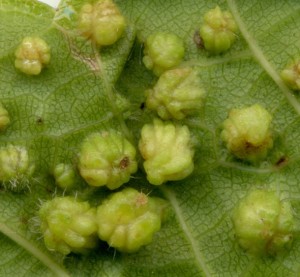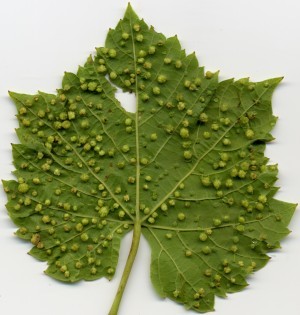Grape Phylloxera
 Scientific Name
Scientific Name
Daktulosphaira vitifoliae
Host
All stages of this insect feed exclusively on grapes.
Symptoms
Phylloxera feeding causes gall formation on leaf and root tissue. These formations can eventually result in rotting of the root, yellowing of the grape foliage and a general overall decline in plant vigor. If roots of European vines become infested then death of the vines is imminent within 3 to 10 years. Symptoms from the leaf form of phylloxera are rather obvious, with small galls about the size of a half a pea forming over the entire leaf surface. These galls are open on the underside of the leaf and contain many small, wingless, yellowish aphids. Heavy infestation by aerial phylloxera causes distortion, necrosis, and premature defoliation of French/American hybrids. Premature defoliation may delay ripening, reduce crop quality and predispose vines to winter injury.
Life Cycle
 This insect possesses a very complex life cycle. It overwinters as an egg attached
to the canes of grape plants and also in the form of tiny aphids on the galls of grape
roots. When plant growth starts in the spring, the root infesting form begins to feed,
while those overwintering on the cane, hatch after the foliage has come out. After
feeding on the leaf, galls begin to form around the insects. Gall formation is a response
by the plant based on the presence and feeding of the phylloxera. The insect does
not form the gall. As soon as the phylloxera reaches maturity, it begins to give birth
to live young inside the gall. These young will also begin to feed on the leaf and
form additional galls. Several generations may be formed on the leaf. Some leaf inhabiting
forms may drop to the ground and burrow down to the roots. Once they reach the roots,
the phylloxera causes the formation of the characteristic root galls which can also
produce multiple generations. In the fall of the year, winged forms will leave the
ground and lay eggs on vines. These eggs hatch into male and female phylloxera and
mating occurs. Each fertilized female lays a single egg on the cane, which overwinters
to continue the cycle the following year.
This insect possesses a very complex life cycle. It overwinters as an egg attached
to the canes of grape plants and also in the form of tiny aphids on the galls of grape
roots. When plant growth starts in the spring, the root infesting form begins to feed,
while those overwintering on the cane, hatch after the foliage has come out. After
feeding on the leaf, galls begin to form around the insects. Gall formation is a response
by the plant based on the presence and feeding of the phylloxera. The insect does
not form the gall. As soon as the phylloxera reaches maturity, it begins to give birth
to live young inside the gall. These young will also begin to feed on the leaf and
form additional galls. Several generations may be formed on the leaf. Some leaf inhabiting
forms may drop to the ground and burrow down to the roots. Once they reach the roots,
the phylloxera causes the formation of the characteristic root galls which can also
produce multiple generations. In the fall of the year, winged forms will leave the
ground and lay eggs on vines. These eggs hatch into male and female phylloxera and
mating occurs. Each fertilized female lays a single egg on the cane, which overwinters
to continue the cycle the following year.
Description
Adult grape phylloxera is a tiny aphid-like insect with a yellow body. The aerial or leaf form is sometimes quite common from mid to late season in Oklahoma, but causes very little, if any damage. The leaf form of grape phylloxera causes the formation of tiny galls to form on the leaf. Inside these galls are many, small wingless aphids Interestingly, a second form of this pest can also infest the roots of grapes causing the same sorts of knots and galls to form.
Control
Please contact your local county extension office for current information.

